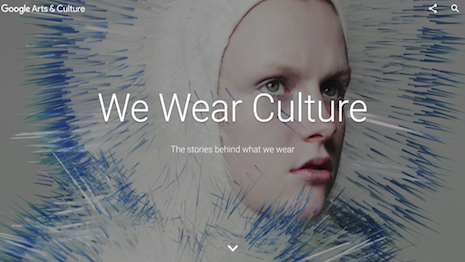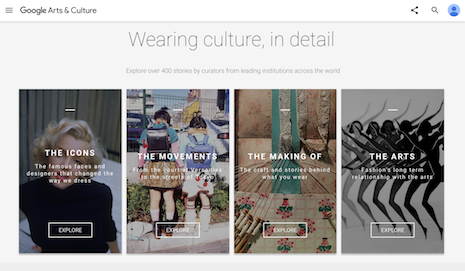 Google Arts & Culture's We Wear Culture launched June 8. Image credit: Google
Google Arts & Culture's We Wear Culture launched June 8. Image credit: Google
As fashion and technology continue to merge, Google has launched a new platform to tell the stories behind the clothes we wear.
Google Arts & Culture, the technology company’s nonprofit cultural institute designed to share arts and culture in a curated online space, has launched “We Wear Culture” to explore wearable culture in detail. The effort tackles trends such as the hoodie to larger picture topics such as the collaboration between art and fashion, craftsmanship and the impact of the fashion industry, among others.
"Google's latest arts and culture project, We Wear Culture, is a great addition to the search engine's portfolio,"said Thomaï Serdari, Ph.D., founder of PIQLuxury, co-editor of Luxury: History Culture Consumption and adjunct professor of luxury marketing at New York University, New York.
"It serves two functions. On the one hand, it allows technology to become a very handy platform through which the medium of fashion can be explained, illustrated and preserved all the while reaching a very broad public," she said. "On the other hand, it also demonstrates Google's unconventional thinking in terms of classifying and discussing fashion."
Ms. Serdari is not affiliated with Google Arts & Culture, but agreed to comment as an industry expert. Google was reached for comment.
Exploration of fashion
Google’s We Wear Culture is in collaboration with the Metropolitan Museum of Art, the Victoria & Albert Museum, the British Fashion Council and Museo Salvatore Ferragamo, among others. In total, We Wear Culture was made by possible via collaborations with 180 other cultural partners and institutions from 40 countries.
The objective of We Wear Culture is to democratize and celebrate the rich history of fashion as well as its creators to explore the industry’s continued influence on society and culture.
Google Arts & Culture's We Wear Culture Web site. Image credit: Google
By aligning with fashion institutions, galleries, museums and designers, Google has crafted an immersive content hub that highlights today’s intersection of fashion and technology.
We Wear Culture currently explores more than 400 fashion-themed stories curated by the aforementioned institutions from around the world.
Section topics include The Icons, where famous faces and designers are explored; The Movements, an exploration of how fashion has changed from the court at Versailles to the streets of Tokyo, for example; The Making Of tells of craftsmanship and creation processes; and The Arts examines the relationship fashion shares with the arts.
Behind-the-scenes #WeWearCulture | How does technology unveil the stories behind what we wear?
We Wear Culture has also digitized memorable museum collections such as Museo Salvatore’s “Is Fashion Art” held at the Italian footwear label’s Florence flagship and “Schiaparelli and Surrealism” hosted by the Victoria and Albert Museum in London.
"What a lot of traditional museums have resisted so far, to embrace fashion as another medium through which culture is disseminated, Google is facilitating with its latest project," NYU's Ms. Serdari said. "Its partners are institutions devoted to the preservation, study and celebration of fashion as material culture, itself a representation of how different groups of people think about it, wear it and use it.
"Several of them are cultural institutions developed under the auspices of celebrated brands, such as Salvatore Ferragamo, or institutions that have been invested in developing collections that cover more than high art, such as the Victoria & Albert Museum," she said.
Archival pieces have also been digitized by Google and explored via 360-degree video, including Chanel and the black dress, Ferragamo stilettos made exclusively for Marilyn Monroe as well as historical pieces such as a bodice worn by Queen Elizabeth I in the 1500s.
#WeWearCulture | Musée des Arts décoratifs: How did the black dress become an icon?
Additional sectors explore designers and notable fashion figures such as actress Audrey Hepburn and Karl Lagerfeld. Recent innovators such as designer Iris van Herpen are also included to demonstrate the new direction fashion is headed.
Craftsmanship topics explore both technique and garment type such as Swiss lacemaking, the story behind the Indian sari and the art of making a Japanese kimono.
Social topics such as the protest tee shirt, the cost of fast fashion, craft cooperatives and how the industry impacts specific countries are also explored for a full, in-depth examination of all things fashion.
Google also has created an Android and iOS mobile application for on-the-go exploration of We Wear Culture.
Tech together
Back in September 2016, Google experimented with the curation of fashion content during New York Fashion Week.
A number of fashion brands hoped to facilitate a direct connection to consumers who searched for related information on Google.
Google allowed brands such as Marc Jacobs and Burberry to provide input and content that came from the latest happenings at global fashion weeks, starting with New York, when users searched for the brands.
Fans were able to browse and shop content coming directly from NYFW, provided by the brands and aggregated by humans instead of an algorithm. The content appeared above the list of Google’s automatically generated site result (see story).
Google has also worked with fashion brands on efforts that build awareness.
For instance, British apparel and accessories brand Turnbull & Asser let consumers visit its London stores from anywhere in the world courtesy of a 360-degree Google tour.
The tour allows customers to virtually view the inside of a few different Turnbull & Asser stores from their computers or mobile devices. This interactive exhibit is an effort to give online customers a boutique experience and incentivize consumers to go in-store to get what they need (see story).
"The stories built around particular items of fashion or the celebrities that have made them famous communicate the particular social context within which fashion evolves, something that no one else has done successfully up to now -- except of course for academic resources, for example The Berg Fashion Library," NYU's Ms. Serdari said.
"Unfortunately, academic resources are not free whereas Google's arts and culture projects are," she said. "What this means is a remarkable value offered to the public through the opportunity to both elevate fashion to its proper status amongst other forms of material culture and to disseminate information about it. In other words, Google's technology both reinforces the exclusivity of fashion and democratizes knowledge about it.
"It is a wonderful way to marry technology with fashion, other than in an ecommerce solution."
